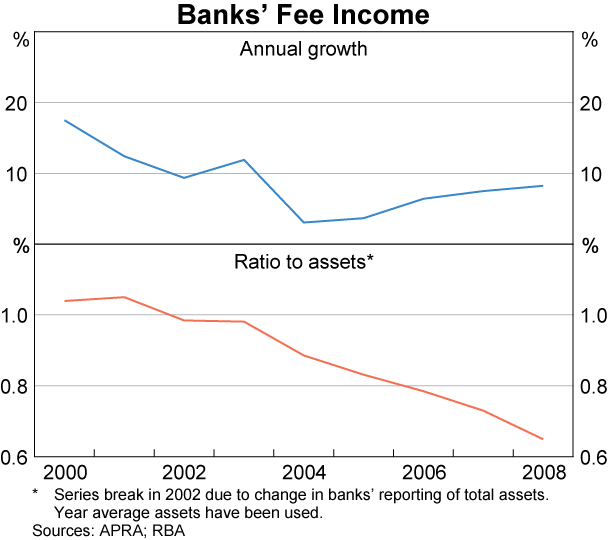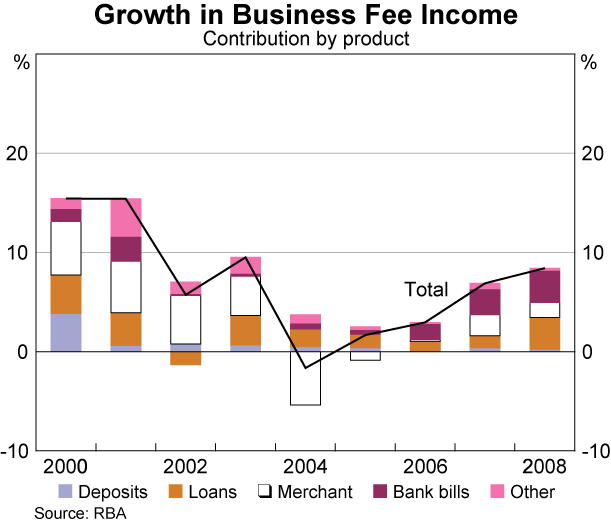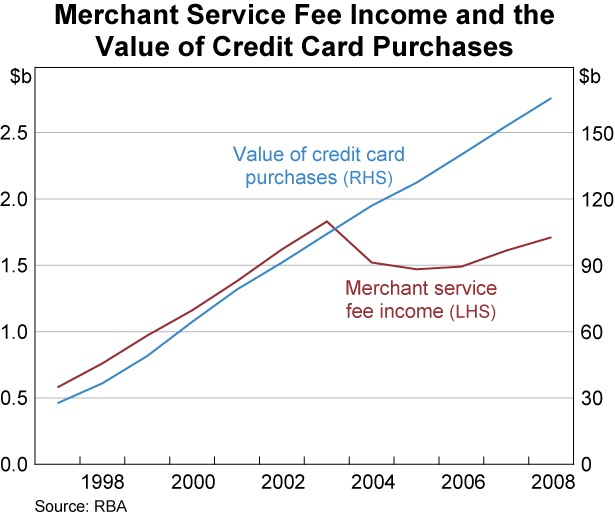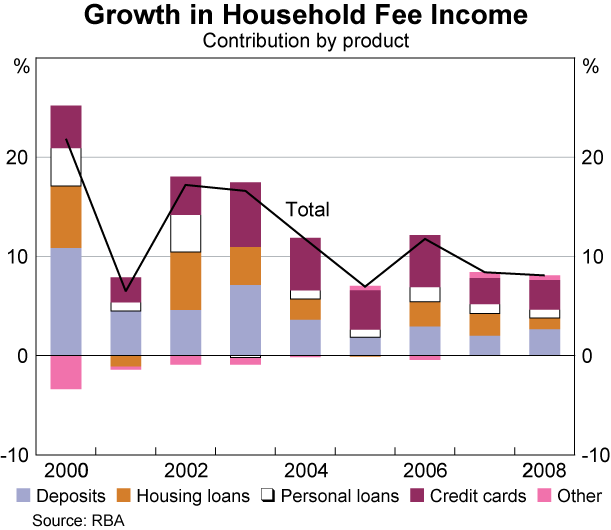Bulletin – May 2009 Banking Fees in Australia[1]
- Download 165KB
The Reserve Bank's annual bank fee survey provides information on the fees that commercial banks earn from their Australian banking operations.[2] This article summarises the results of the latest survey, relating to banks' 2008 financial year. It covers 18 institutions, which together account for around 90 per cent of the total assets of the Australian banking sector. Following a recommendation of a recent Senate Inquiry into bank fees and charges, this survey also collected detailed data on banks' exception fees for the first time.[3]
As has been the case for a number of years, banks' domestic fee income grew less quickly than their balance sheet assets in 2008. For both businesses and households, the growth in fee income appears to have been mainly the result of greater use of banking services, rather than higher unit charges.
Fees from Banking Activities
Total domestic fee income of participant banks rose by 8 per cent in 2008 to $11.6 billion, with fee income from businesses and households growing at a similar rate (Table 1, Graph 1). As has been the case since 2002, growth in fee income was slower than the growth in banks' balance sheet assets. As a consequence, the ratio of fee income to assets has continued to decline.
| Businesses | Households | Total | ||||||
|---|---|---|---|---|---|---|---|---|
| $ million | Annual change Per cent |
Share of total Per cent |
$ million | Annual change Per cent |
Share of total Per cent |
$ million | Annual change Per cent |
|
| 2006 | 5,817 | 3 | 58 | 4,135 | 12 | 42 | 9,953 | 6 |
| 2007 | 6,218 | 7 | 58 | 4,483 | 8 | 42 | 10,701 | 8 |
| 2008 | 6,741 | 8 | 58 | 4,845 | 8 | 42 | 11,586 | 8 |
|
Source: RBA |
||||||||

Businesses
Banks' fee income from businesses increased by 8 per cent in 2008 to $6.7 billion, faster than the annual average growth rate of 4 per cent over the preceding five years (Table 2 and Graph 2). The pick-up in growth in business fee income was driven by faster growth in fee income from loans and bank bill facilities. Nonetheless, the growth in fee income in 2008 was less than the growth in the value of both business loans and business deposits, suggesting that it was mainly the result of greater use of banking services.

Bank bill fee income – which includes charges for arranging bank bill facilities and accepting or endorsing bank bills – increased by 15 per cent over 2008, while fee income from business loans increased by 12 per cent. These increases are consistent with the strong growth in business credit over the 2008 financial year, which reflected strong underlying demand for debt funding from businesses, as well as increased intermediation of business finance amid the turbulence in capital markets.
| 2006 | 2007 | 2008 | Growth 2008 Per cent | Average growth 2002–2007 Per cent | |
|---|---|---|---|---|---|
| Deposits | 812 | 834 | 848 | 2 | 3 |
| Loans | 1,569 | 1,638 | 1,838 | 12 | 7 |
| Merchant service fees | 1,486 | 1,611 | 1,706 | 6 | 0 |
| Bills | 1,228 | 1,380 | 1,581 | 15 | 5 |
| Other fees | 723 | 754 | 767 | 2 | 6 |
| Total | 5,817 | 6,218 | 6,741 | 8 | 4 |
|
Source: RBA |
|||||
Aggregate merchant service fees – which are charged to merchants for providing credit and debit card transaction services – increased by 6 per cent in 2008, slower than the 8 per cent recorded in 2007. Despite having risen over the past three years, the level of merchant service fees remains below its peak in 2003, just prior to the introduction of the RBA's credit card interchange fee reforms (Graph 3). Total merchant service fees on credit card transactions increased by 5 per cent, somewhat slower than the growth in the value of credit card transactions over 2008. Merchant service fees on debit card transactions rose by 8 per cent.

Households
Banks' fee income from households increased by 8 per cent in 2008 to $4.9 billion, slower than its annual average growth rate of 11 per cent over the previous five years (Table 3 and Graph 4). This mainly reflected slower growth in fee income from credit cards and housing loans.
| 2006 | 2007 | 2008 | Growth 2008 Per cent | Average growth 2002–2007 Per cent | |
|---|---|---|---|---|---|
| Loans: | |||||
| – Housing | 906 | 997 | 1,045 | 5 | 9 |
| – Personal | 405 | 445 | 486 | 9 | 9 |
| – Credit cards | 1,089 | 1,199 | 1,332 | 11 | 23 |
| Deposits | 1,669 | 1,754 | 1,877 | 7 | 8 |
| Other fees | 67 | 88 | 105 | 20 | 0 |
| Total | 4,135 | 4,483 | 4,845 | 8 | 11 |
|
Source: RBA |
|||||
Fee income from housing loans increased by 5 per cent in 2008, well below its average annual growth of 9 per cent between 2002 and 2007. The decline in the number of new housing loans in 2008 contributed to the moderation in housing fee income growth. Unit fees on housing loans appear to have risen a little. Fee income from personal loans rose by 9 per cent, broadly in line with the rate of growth in personal credit.

Credit card fee income increased by 11 per cent in 2008, noticeably slower than the average annual growth of 23 per cent over the previous five years. Within the total, account servicing fees rose by 7 per cent, transaction fees (such as cash advance fees) rose by 14 per cent, and other fees, which are mainly exception fees (see below), increased by 14 per cent. These increases largely reflect a higher number and growth in use of credit cards, though unit charges, particularly those that are levied as a percentage of the value of the transaction, have risen slightly over the year (Table 4).
| 2006 | 2007 | 2008 | |
|---|---|---|---|
| Annual fees ($)(b) | |||
| – No-frills cards | 41 | 48 | 49 |
| – Standard cards | 28 | 29 | 29 |
| – Standard rewards-based cards | 85 | 85 | 85 |
| – Gold rewards-based cards | 140 | 140 | 140 |
| Cash advance fees(c) | |||
| Own Bank's ATM | |||
| – $ charge | 1.4 | 1.4 | 1.4 |
| – Per cent of value | 1.1 | 1.1 | 1.3 |
| Other Bank's ATM | |||
| – $ charge | 1.6 | 1.6 | 1.6 |
| – Per cent of value | 1.4 | 1.4 | 1.6 |
| Overseas ATM | |||
| – $ charge | 3.6 | 3.6 | 3.6 |
| – Per cent of value | 1.4 | 1.4 | 1.6 |
| Foreign currency conversion fee (per cent of value) | 2.4 | 2.5 | 2.5 |
| Late payment fee ($) | 31 | 31 | 31 |
| Over-limit fee ($) | 30 | 30 | 30 |
|
(a) Simple average fees for cards with interest-free periods issued by
major banks, except for the annual fee on no-frills cards, which is based
on a wider sample of banks. Note that changes in the sample affect the
average fee. Sources: Canstar Cannex; RBA |
|||
Fee income on deposits rose by 7 per cent, a little faster than the 5 per cent increase recorded in 2007. This pick-up was less than the 13 per cent increase in the value of household deposits, and a little more than the 5 per cent rise in the number of deposit accounts. The decline in the equity market has encouraged households to shift their savings into bank deposits, while financial institutions have also been competing more vigorously for deposit funding, given the increased cost and reduced availability of capital market funding.
Exception Fees
An exception fee is charged by a bank when a customer breaches the terms of a banking product, typically by making a late payment, overdrawing a deposit account or exceeding a credit limit. On the recommendation of a recent Senate Inquiry into bank fees and charges, this year's survey collected detailed data on banks' exception fees. This is the first time that exception fee data have been collected, so comparisons cannot be made with previous years. However, future surveys will continue to collect these data, providing an insight into how exception fees move over time.
In 2008, exception fees totalled $1.2 billion, around 10 per cent of banks' total fee income (Table 5). Around 83 per cent of exception fees were levied on households, mainly on their deposit and credit card accounts. Two-thirds of businesses' exception fees were levied on their deposit accounts.
| Households | Businesses | Total | ||||
|---|---|---|---|---|---|---|
| Value $m | Share of total fees Per cent |
Value $m | Share of total fees Per cent |
Value $m | Share of total fees Per cent |
|
| Deposits | 490 | 26 | 125 | 15 | 615 | 23 |
| Loans | 471 | 16 | 76 | 4 | 547 | 12 |
| – Housing | 38 | 4 | .. | .. | .. | .. |
| – Personal | 18 | 4 | .. | .. | .. | .. |
| – Credit cards | 415 | 31 | .. | .. | .. | .. |
| Total(a) | 961 | 20 | 201 | 3 | 1,162 | 10 |
|
(a) Total fees for businesses include merchant service fees, which do not have an ‘exception fee’ component. Source: RBA |
||||||
Footnotes
This article was prepared by Ramsay McLachlan and Michelle Wright from Domestic Markets Department. [1]
The focus of the survey is fee income earned by banks in the process of taking deposits, making loans and providing payment services. Other forms of non-interest income, such as from funds management and insurance operations, are excluded from the survey. The survey relates to fee income earned by each participant bank over the course of their respective financial years. The data from the survey are published in RBA Bulletin Table F.6. [2]
The Senate's request was outlined in Australian Securities and Investments Commission (Fair Bank and Credit Card Fees) Amendment Bill 2008. [3]